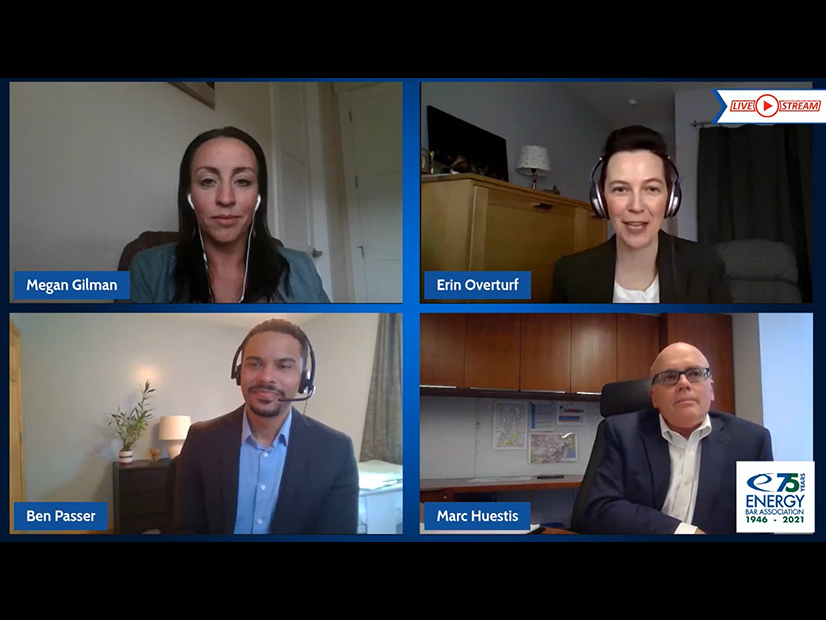Colorado regulator Megan Gilman worries that the electrification of home heating could leave fewer natural gas customers paying increasingly high bills.
But Consolidated Edison executive Marc Huestis told the Energy Bar Association’s annual meeting Wednesday that could be avoided by continued use of natural gas infrastructure for delivering low-carbon fuel.
That’s the hope of the Low-Carbon Resources Initiative (LCRI), a joint project of the Electric Power Research Institute and the Gas Technology Institute that is exploring the role low-carbon chemical energy carriers such as clean hydrogen, bioenergy and renewable natural gas can play in an economy-wide decarbonization.
“The [local distribution companies] and the gas system could provide a very elegant solution to this problem,” said Huestis, Con Ed’s senior vice president of gas operations, during a panel discussion on the future of natural gas utilities in a carbon-constrained world. “If we can innovate and develop at scale affordable, low-carbon resources that leverage the existing natural gas infrastructure — there’s 2.5 million miles of pipelines across this country — think of the potential: Instead of converting building by building, customer by customer, millions of separate locations, we can decarbonize the fuel at its source and use it in concert with electrification. We’ll get there faster, and we’ll get there cheaper.”
Con Ed’s system serves 3.4 million electric customers and 1.1 million gas customers in New York City and Westchester County. “On a cold winter day, our gas system delivers three times as much energy as our electric system does on a peak summer day. So this is a huge transformation,” he said.
Last month, New York City, Con Ed and National Grid released a study on pathways to a carbon-neutral future that concluded a path of heavy electrification would shift the current summer peaking electric system to a winter peak, increasing that peak by 86%.
“You can imagine in a dense urban environment of New York City that would be quite a logistical challenge to increase the demand and ability of the electric system that much,” Huestis said. “The same study shows the low-carbon fuel pathway, combined with electrification, would significantly mitigate the impact on the electric system and actually keep it as a summer peaking system.”
Policymakers should “leverage the resiliency of the natural gas system so we’re not in an electric home, with an electric [vehicle] and the electric system has an outage,” he said. “There’s value in diversity. There’s value in the resiliency of the gas system.
“It’s going to take an integrated energy system, where we’re leveraging the benefits of both the electric system and the gas system to make this work, because the gas system can really mitigate the impact on what we have to do with the infrastructure build out to support this decarbonization effort.”
‘A Sea of Ambiguity’
In 2019, Colorado lawmakers approved a bill requiring the state to reduce greenhouse gas emissions 26% below 2005 levels by 2025 (HB 19-1261). The legislation also targets a 50% reduction by 2030 and a 90% cut by 2050.
But the state hasn’t set any targets for how natural gas use should be reduced, making regulators feel like they are “swimming in a sea of ambiguity,” said Gilman, a member of the Colorado Public Utilities Commission.
“So, not to say we have it all figured out on the electric decarbonization side of things — I’m sure there will be a lot of hard decisions still to come — but the natural gas side of things feels so underdeveloped,” she said. “To me it’s really bound to produce both excitement and anxiety among different stakeholders as we all try to figure out what decarbonization in this sector and its end uses really look like.”
Gilman said the PUC has an important role in making sure the legislature’s targets are achieved.
“If we don’t plan properly and we get to the point where it’s either too expensive or we can’t avoid … the worst circumstances for our lowest-income consumers, I think this could get politically untenable,” she said.
“If we do see considerable attrition to either customer accounts or load, it’s reasonable to assume that rates would potentially go up to cover the costs of operating the system. And so the assumption … is that your lowest-income consumers lack the capital to electrify. What a lot of people are concerned about is if we saw rising costs, those folks would be left on a system that is getting increasingly less affordable.”
The PUC opened an investigatory docket last year on the future of natural gas, but Gilman said there are legal challenges to discussing the issue.
“There are always ongoing proceedings. … There is never not a natural gas proceeding. And so it’s very hard in some ways to talk about issues at the commission because we always have ongoing adjudicated proceedings that we have to stay away from. It can feel like a minefield where we’re tiptoeing around certain things.”
To avoid stranded gas assets, she said regulators will need to change depreciation rules to make the “useful life” reflect policy scenarios rather than the “material science perspective” they have used historically.
“Infrastructure going in right now is going to be depreciated past 2060 [under current rules],” she said. “That’s a long time.”
Minnesota Activist Seeks Equity
Also appearing on the EBA panel was Ben Passer, lead director for energy access and equity for Fresh Energy, a nonprofit that seeks “equitable carbon-neutral economies.” An attorney, Passer leads Fresh Energy’s advocacy efforts at the Minnesota Public Utilities Commission and state capital.
He called for investments in weatherization and “deep energy retrofits” to prepare homes for cold-climate air source heat pumps. Natural gas supplies heating to almost two-thirds of Minnesota households, he noted, well above the national average of below 50%.






